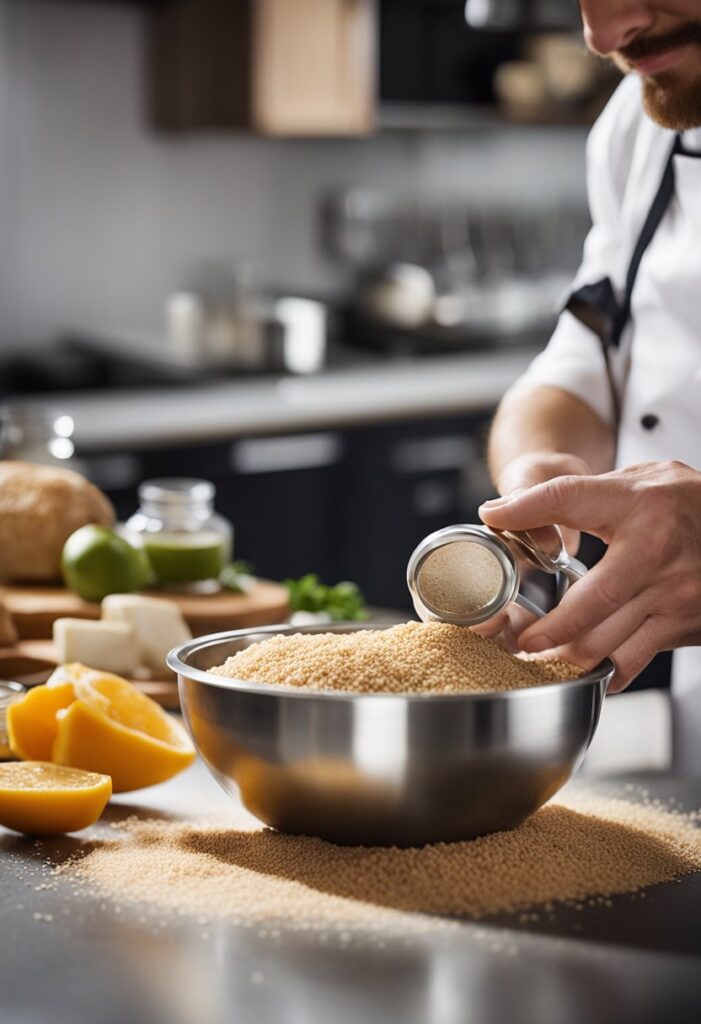Low sodium breakfast sausage is a healthy option for people who are looking to reduce their sodium intake. Sausage is a popular breakfast food that is high in sodium and can be detrimental to one’s health if consumed in large amounts. However, with a few simple tweaks to the recipe, it is possible to make a low sodium breakfast sausage that is just as delicious as the original.
delicious and healthy low sodium breakfast sausage Recipe
Description
This low sodium breakfast sausage recipe combines lean ground meat with a mix of sage, thyme, rosemary, fennel seeds, and peppers. It uses low sodium broth for moisture and optional egg white and breadcrumbs for binding. Form the mixture into patties or links and cook by pan-frying, grilling, or baking. Enjoy a flavorful and healthy breakfast option that’s easy to prepare.
Ingredients
Instructions
- In a large bowl, combine ground meat, herbs, spices, broth, and optional binding agents.
- Mix thoroughly with hands until well combined.
- Form mixture into small patties or links.
- Cook using preferred method: pan-fry, grill, or bake at 375°F for 20-25 minutes until fully cooked.
Notes
- Overall, there are several alternative cooking methods that can be used to prepare low sodium breakfast sausages. These methods can help to reduce the amount of sodium in the sausages while maintaining their flavor and texture.
Table of Contents

One of the main reasons why people choose to make their own low sodium breakfast sausage is to avoid the high levels of sodium found in store-bought sausage. High sodium intake has been linked to a number of health problems, including high blood pressure and heart disease. By making their own sausage, people can control the amount of salt added to the recipe and ensure that it is a healthier option.
Making low sodium breakfast sausage is not as difficult as it may seem. With the right ingredients and a little bit of know-how, anyone can make a delicious and healthy breakfast sausage that is low in sodium. In the following article, we will provide a recipe for low sodium breakfast sausage and tips for making it a staple in your breakfast routine.
Understanding Sodium in Breakfast Sausages

Sodium is an essential nutrient that plays a vital role in regulating blood pressure, fluid balance, and nerve function. However, excessive sodium intake can lead to several health problems, including hypertension, heart disease, and stroke. Breakfast sausages are a popular breakfast food that can be high in sodium.
The amount of sodium in breakfast sausages can vary widely depending on the brand, type, and serving size. Some sausages can contain as much as 500 milligrams of sodium per serving, while others may have less than 100 milligrams. It is essential to read the nutrition labels carefully to determine the sodium content of breakfast sausages.
One way to reduce the sodium content in breakfast sausages is to choose low-sodium options. Low-sodium breakfast sausages typically have less than 140 milligrams of sodium per serving. However, it is important to note that low-sodium sausages may contain other additives to enhance flavor and texture.
Another way to reduce sodium intake is to limit the serving size of breakfast sausages. Eating smaller portions can help reduce overall sodium intake and promote a balanced diet.
In summary, understanding the sodium content of breakfast sausages is essential for maintaining a healthy diet. Choosing low-sodium options and limiting serving sizes can help reduce sodium intake and promote overall health.
Health Benefits of Low Sodium Diets

Low sodium diets have been shown to have numerous health benefits. Here are some of the key benefits:
Lowered Risk of High Blood Pressure
Excessive sodium intake has been linked to high blood pressure, which can increase the risk of heart disease and stroke. By reducing sodium intake, individuals can lower their risk of developing high blood pressure and related health problems.
Reduced Risk of Kidney Disease
High sodium intake has been linked to an increased risk of kidney disease. By reducing sodium intake, individuals can help protect their kidneys and reduce their risk of developing kidney problems.
Improved Heart Health
A low sodium diet can help improve heart health by reducing the risk of heart disease and stroke. Additionally, it can help lower cholesterol levels and improve blood vessel function, which can further reduce the risk of heart problems.
Better Weight Management
A low sodium diet can help with weight management by reducing water retention and bloating. Additionally, it can help individuals make healthier food choices, which can lead to weight loss and improved overall health.
Overall Improved Health
By reducing sodium intake, individuals can improve their overall health and reduce their risk of numerous health problems. This can lead to a longer, healthier life with fewer health problems and a better quality of life.
Key Ingredients for Low Sodium Sausage
When it comes to making low sodium breakfast sausage, choosing the right ingredients is crucial. Here are some key ingredients that can help you make delicious and healthy low sodium sausage:
Ground Meat
The type of ground meat you use will have a significant impact on the taste and texture of your sausage. Ground turkey, chicken, or pork are all good options for low sodium sausage. It is important to choose lean ground meat to keep the fat content low.
Spices
Spices are essential in giving your sausage flavor. To keep the sodium content low, it is important to use fresh herbs and spices instead of pre-made seasoning blends. Some good options include sage, thyme, rosemary, fennel seeds, and black pepper.
Salt Substitute
To make low sodium sausage, you need to replace the salt with a salt substitute. There are many salt substitutes available on the market, such as potassium chloride, that can be used to replace salt in recipes. It is important to use the right amount of salt substitute to ensure that your sausage is not too salty or bland.
Liquid
Adding a liquid to your sausage mixture can help keep it moist and tender. Low sodium chicken or vegetable broth are good options to use in place of water. You can also use low-fat milk or yogurt to add creaminess to your sausage.
By using these key ingredients, you can create a delicious and healthy low sodium breakfast sausage that is sure to satisfy your taste buds.
Selecting the Right Meat
When it comes to making low sodium breakfast sausage, choosing the right meat is crucial. The type of meat used will affect the flavor, texture, and overall quality of the sausage.
One of the best options for low sodium breakfast sausage is lean ground turkey. Turkey is a great choice because it is lower in fat than other meats, making it a healthier option. It is also a good source of protein, which is important for a balanced breakfast.
Another option is lean ground chicken. Like turkey, chicken is low in fat and high in protein. It also has a mild flavor that can be easily seasoned to create delicious breakfast sausage.
If you prefer pork, look for lean ground pork. This can be a bit harder to find, but it is worth the effort. Pork has a rich, savory flavor that is perfect for breakfast sausage. However, it is important to choose lean cuts to keep the fat content low.
No matter what type of meat you choose, be sure to read the labels carefully. Look for ground meat that is labeled “lean” or “extra lean” to ensure that it is low in fat. You can also ask your butcher for recommendations on the best cuts of meat for low sodium breakfast sausage.
By selecting the right meat, you can create delicious low sodium breakfast sausage that is both healthy and flavorful.
Herbs and Spices for Flavor
When it comes to creating a flavorful low sodium breakfast sausage recipe, herbs and spices play a crucial role. By using the right combination of herbs and spices, you can add depth and complexity to your sausage without relying on salt.
One of the most popular herbs used in breakfast sausage recipes is sage. Its earthy, slightly peppery flavor pairs well with the richness of pork. Other herbs that work well in breakfast sausage include thyme, marjoram, and rosemary. These herbs add a subtle aroma and flavor to the sausage.
In addition to herbs, spices can also be used to enhance the flavor of your low sodium breakfast sausage. Black pepper is a classic choice, but you can also experiment with other spices such as cumin, coriander, and paprika. These spices add a warm, slightly smoky flavor to the sausage.
To get the most out of your herbs and spices, it’s important to use fresh, high-quality ingredients. You can also experiment with different combinations of herbs and spices to create a unique flavor profile that suits your taste. With a little creativity and experimentation, you can create a delicious low sodium breakfast sausage that is full of flavor.
Low Sodium Binding Agents
When making low sodium breakfast sausage, it’s important to find the right binding agents to hold the meat together. Traditional sausage recipes often use salt as a binding agent, but there are several low sodium alternatives that work just as well.
One option is to use egg whites as a binding agent. Egg whites are high in protein and can help hold the meat together without adding any sodium. Another option is to use breadcrumbs or oats. These dry ingredients can absorb moisture and help bind the meat together without adding any sodium.
Xanthan gum is another low sodium binding agent that can be used in small amounts. It’s a natural thickener that can help hold the meat together and improve texture. However, it’s important to use xanthan gum sparingly, as too much can make the sausage gummy and unpleasant.
Overall, there are several low sodium binding agents that can be used in breakfast sausage recipes. By experimenting with different ingredients, you can find the right combination to create a delicious and healthy sausage that’s low in sodium.
Recipe Preparation Steps
To make low sodium breakfast sausage, follow these simple steps:
- In a large mixing bowl, combine ground turkey, salt-free seasoning blend, fennel seeds, black pepper, and red pepper flakes. Mix well until all ingredients are evenly distributed.
- Using your hands, form the mixture into small patties, about 2-3 inches in diameter and 1/2 inch thick.
- Heat a large skillet over medium heat. Add a small amount of oil to the skillet and swirl to coat the bottom.
- Add the sausage patties to the skillet and cook for 3-4 minutes on each side, or until browned and cooked through.
- Serve the low sodium breakfast sausage patties hot with your favorite breakfast sides, such as eggs, toast, or fruit.
By following these simple steps, you can enjoy delicious and healthy low sodium breakfast sausage that is perfect for any morning meal.
Mixing Ingredients
To make low sodium breakfast sausage, the ingredients must be properly mixed to ensure that the flavor is evenly distributed. The following are the steps to follow when mixing the ingredients:
- In a large bowl, combine the ground pork, salt-free seasoning blend, and any other desired spices or herbs.
- Use your hands to mix the ingredients thoroughly. Be sure to incorporate the spices and herbs evenly throughout the pork.
- Once the ingredients are mixed, form the pork mixture into patties or links of your desired size.
- If you are not planning on cooking the sausage immediately, wrap the patties or links in plastic wrap and store them in the refrigerator for up to 24 hours.
- When you are ready to cook the sausage, heat a skillet over medium heat and add a small amount of oil or cooking spray.
- Add the sausage patties or links to the skillet and cook for 3-4 minutes per side, or until fully cooked.
By following these simple steps, you can easily create delicious low sodium breakfast sausage that is sure to be a hit with your family and friends.
Shaping and Forming Sausages
To shape and form the low sodium breakfast sausages, the mixture needs to be divided into equal portions. The portions can be shaped into patties or links, depending on personal preference.
For patties, take a portion of the mixture and flatten it into a disc shape. The patties should be about 1/2 inch thick and 3-4 inches in diameter. To ensure even cooking, make sure the patties are of equal size.
For links, take a portion of the mixture and roll it into a cylinder shape. The cylinder should be about 4-5 inches long and 1 inch in diameter. Twist the cylinder in opposite directions to form links. The links should be about 2-3 inches long.
To make the shaping process easier, wet your hands with cold water before handling the mixture. This will prevent the mixture from sticking to your hands and make it easier to shape.
Once the sausages are shaped, they can be cooked immediately or stored in the refrigerator for later use. When cooking, make sure to cook the sausages thoroughly to an internal temperature of 160°F.
Shaping and forming sausages is a simple process that can be easily mastered with practice. With the right technique, homemade low sodium breakfast sausages can be just as delicious and flavorful as store-bought versions.
Cooking Techniques
When it comes to cooking low sodium breakfast sausage, there are a few techniques that can help ensure that the sausage is cooked to perfection and retains its flavor. Here are some cooking techniques that can be used:
Pan-Frying
Pan-frying is a popular cooking technique for breakfast sausages. To pan-fry low sodium breakfast sausage, heat a non-stick pan over medium heat and add a small amount of oil. Add the sausages to the pan and cook for 8-10 minutes, turning occasionally until they are browned on all sides and cooked through.
Grilling
Grilling is another great option for cooking low sodium breakfast sausage. Preheat the grill to medium-high heat and lightly oil the grates. Add the sausages to the grill and cook for 10-12 minutes, turning occasionally until they are browned on all sides and cooked through.
Baking
Baking is a simple and easy way to cook low sodium breakfast sausage. Preheat the oven to 375°F and line a baking sheet with parchment paper. Place the sausages on the baking sheet and bake for 20-25 minutes, or until they are browned and cooked through.
No matter which cooking technique you choose, it’s important to make sure that the sausage is cooked to a safe internal temperature of 160°F. Use a meat thermometer to ensure that the sausage has reached this temperature before serving.
Serving Suggestions
Low sodium breakfast sausage is a versatile dish that can be served in many different ways. Here are a few ideas for how to enjoy this tasty and healthy meal:
- As part of a classic breakfast: Serve the sausage with eggs, toast, and a side of fruit for a traditional breakfast that’s both satisfying and nutritious.
- In a breakfast sandwich: Use the sausage to make a delicious breakfast sandwich. Add a slice of cheese, some avocado, and a dollop of hot sauce for a tasty twist on a classic.
- In a breakfast bowl: Top a bowl of cooked quinoa or brown rice with the sausage, some chopped veggies, and a fried egg for a hearty and healthy breakfast bowl.
- As a protein-packed snack: Cut the sausage into bite-sized pieces and pack it in a container for a quick and easy snack on the go.
No matter how you choose to enjoy it, low sodium breakfast sausage is a delicious and healthy way to start your day.
Storing Homemade Sausages
Once the low sodium breakfast sausages are made, it is important to store them properly to maintain their quality and freshness. Here are some tips on how to store homemade sausages:
- Refrigerate: Homemade sausages should be refrigerated immediately after they are made. Place them in an airtight container or wrap them tightly in plastic wrap or aluminum foil. They can be stored in the refrigerator for up to 4 days.
- Freeze: If you are not planning to use the sausages within 4 days, you can freeze them for later use. Wrap each sausage individually in plastic wrap or aluminum foil and place them in a freezer-safe container or freezer bag. They can be stored in the freezer for up to 3 months.
- Label and Date: It is important to label and date the sausages before storing them in the refrigerator or freezer. This will help you keep track of how long they have been stored and ensure that you use them before they expire.
- Thawing: If you are planning to use the sausages that have been frozen, you will need to thaw them first. The best way to thaw sausages is to place them in the refrigerator overnight. You can also thaw them in the microwave or by placing them in a bowl of cold water.
By following these simple tips, you can ensure that your homemade low sodium breakfast sausages stay fresh and delicious for longer.
Nutritional Information
When it comes to breakfast sausage, keeping an eye on the nutritional content is essential. Here is the nutritional information for our low sodium breakfast sausage recipe:
- Calories: Each serving of our low sodium breakfast sausage contains approximately 70 calories.
- Protein: Our sausage is a great source of protein, with each serving containing around 8 grams of protein.
- Fat: Our sausage is relatively low in fat, with each serving containing approximately 3 grams of fat.
- Sodium: As the name suggests, our low sodium breakfast sausage recipe contains significantly less sodium than traditional breakfast sausages. Each serving contains only around 150 milligrams of sodium.
- Carbohydrates: Our sausage is low in carbohydrates, with each serving containing only around 2 grams of carbohydrates.
Overall, our low sodium breakfast sausage recipe is a great choice for those looking for a healthier breakfast option. It is high in protein and low in both fat and sodium, making it a great addition to a balanced diet.
Adjusting the Recipe for Dietary Needs
For those with dietary restrictions, this low sodium breakfast sausage recipe can be easily adapted to meet their needs. Here are some tips for adjusting the recipe:
Gluten-Free
To make this recipe gluten-free, simply replace the breadcrumbs with gluten-free breadcrumbs or almond flour. Make sure to check the labels of all ingredients to ensure they are gluten-free.
Paleo
For a paleo-friendly version, replace the breadcrumbs with almond flour and omit the brown sugar. Use coconut aminos instead of soy sauce and make sure the sausage is made with pasture-raised pork.
Vegetarian
For a vegetarian version, replace the pork with a plant-based protein such as tempeh or tofu. Use vegetable broth instead of chicken broth and omit the Worcestershire sauce.
Vegan
To make this recipe vegan, replace the pork with a plant-based protein such as tempeh or tofu. Use vegetable broth instead of chicken broth and replace the egg with a flax egg (1 tablespoon of ground flaxseed mixed with 3 tablespoons of water).
By making these simple adjustments, anyone can enjoy a delicious and low sodium breakfast sausage that meets their dietary needs.
Alternative Cooking Methods
There are several alternative cooking methods that can be used to prepare low sodium breakfast sausages. These methods can help to reduce the amount of sodium in the sausages while maintaining their flavor and texture.
Grilling
Grilling is a great way to cook low sodium breakfast sausages. It allows the excess fat to drip away from the sausages, resulting in a leaner and healthier meal. To grill the sausages, preheat the grill to medium-high heat. Place the sausages on the grill and cook for 5-7 minutes per side, or until they are browned and fully cooked.
Baking
Baking is another option for cooking low sodium breakfast sausages. This method is easy and convenient, and it allows you to cook a large number of sausages at once. To bake the sausages, preheat the oven to 375°F. Place the sausages on a baking sheet and bake for 20-25 minutes, or until they are browned and fully cooked.
Pan-Frying
Pan-frying is a classic method for cooking breakfast sausages. While it may not be the healthiest option, it can still be used to prepare low sodium sausages. To pan-fry the sausages, heat a non-stick skillet over medium heat. Add the sausages and cook for 5-7 minutes per side, or until they are browned and fully cooked.


